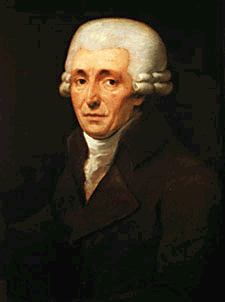Franz Joseph Haydn
Born: Rohrau, lower Austria, (baptized April 1), 1732
Died: Vienna, May 31, 1809
 Born second of twelve children to a poor but music-loving family, at the age of eight Franz Joseph was accepted in the choir of St. Stephen's Cathedral in Vienna. In 1749, after enduring nine years at the cathedral, he was turned out when his voice broke. Without money, a job, or a home, the young man somehow survived by singing, playing the harpsichord where he could, and teaching, all the time practicing and continuing to study music. He also began composing and making connections, and was given his first professional position leading the orchestra of a Count Morzin of Bohemia. His first symphony led to his being engaged in 1761 as orchestra conductor to the Hungarian Prince Paul Anton Esterházy. Haydn spent thirty years in the employ of the Esterházys, virtually as a servant, but nevertheless composing some 90 symphonies, two dozen operas, a number of masses, and vast amounts of chamber music. His fame spread across Europe due to the publication of his music and, almost unknown to him, the immense popularity of his music set the standard of the musical tastes and techniques of the next half century. He met the young Mozart in 1781 and the two became close friends and admirers of the other's music.
Born second of twelve children to a poor but music-loving family, at the age of eight Franz Joseph was accepted in the choir of St. Stephen's Cathedral in Vienna. In 1749, after enduring nine years at the cathedral, he was turned out when his voice broke. Without money, a job, or a home, the young man somehow survived by singing, playing the harpsichord where he could, and teaching, all the time practicing and continuing to study music. He also began composing and making connections, and was given his first professional position leading the orchestra of a Count Morzin of Bohemia. His first symphony led to his being engaged in 1761 as orchestra conductor to the Hungarian Prince Paul Anton Esterházy. Haydn spent thirty years in the employ of the Esterházys, virtually as a servant, but nevertheless composing some 90 symphonies, two dozen operas, a number of masses, and vast amounts of chamber music. His fame spread across Europe due to the publication of his music and, almost unknown to him, the immense popularity of his music set the standard of the musical tastes and techniques of the next half century. He met the young Mozart in 1781 and the two became close friends and admirers of the other's music.
Known today as the "The father of the Symphony and the String quartet", Haydn actually invented neither, but did develop them into the forms that eventually swept throughout Europe. Joseph Haydn was evidently an unassuming man who seemingly without effort turned out literally hundreds of sonatas, quartets, symphonies, operas and concertos during his career. His music is always extremely well-crafted and seemingly simple and charming, but there are always flights of fancy and pure jokes amidst the classical veneer. The most famous example is the "surprise" in the second movement of his Symphony no. 94 in G major, but his humor can also be heard in the finale of the Symphony no. 82 , nicknamed "the Bear" as the bass drone and chortling bassoons in the finale conjured images of a dancing bear in the minds of the symphony's first audiences. Haydn's modernization of the Rococo string quartet turned it into the intimate form we know, in which all four instruments are treated with equal importance. The late String Quartet, op. 76 no.3 gives an idea of the melodic elegance found in the 83 quartets composed by this master of the genre.When Prince Nicolaus Esterházy died in 1790 (he had succeeded Prince Paul in 1762 and had retained Haydn's services), Haydn was dismissed by his successor. With a generous pension and income from publications and pupils, Haydn moved to Vienna. He was invited to London by impressario J. P. Salomon for a series of concerts. During this visit and a second trip to England, Haydn composed his last twelve "London" symphonies, his crowning achievements in the genre. He was also asked to compose an oratorio in the style of Handel. He composed two, and his music transforms the majesty of the Baroque into that of the early nineteenth century with such choruses as "The Heavens are Telling" from The Creation, premiered in 1798.
By 1802, Haydn, now an old man, felt himself played out. He spent his last years enjoying the adulation that came his way from all over Europe. When in the spring of 1809, the French under Napoleon began their destruction of Vienna, Haydn suffered a quick decline and died on May 31.
